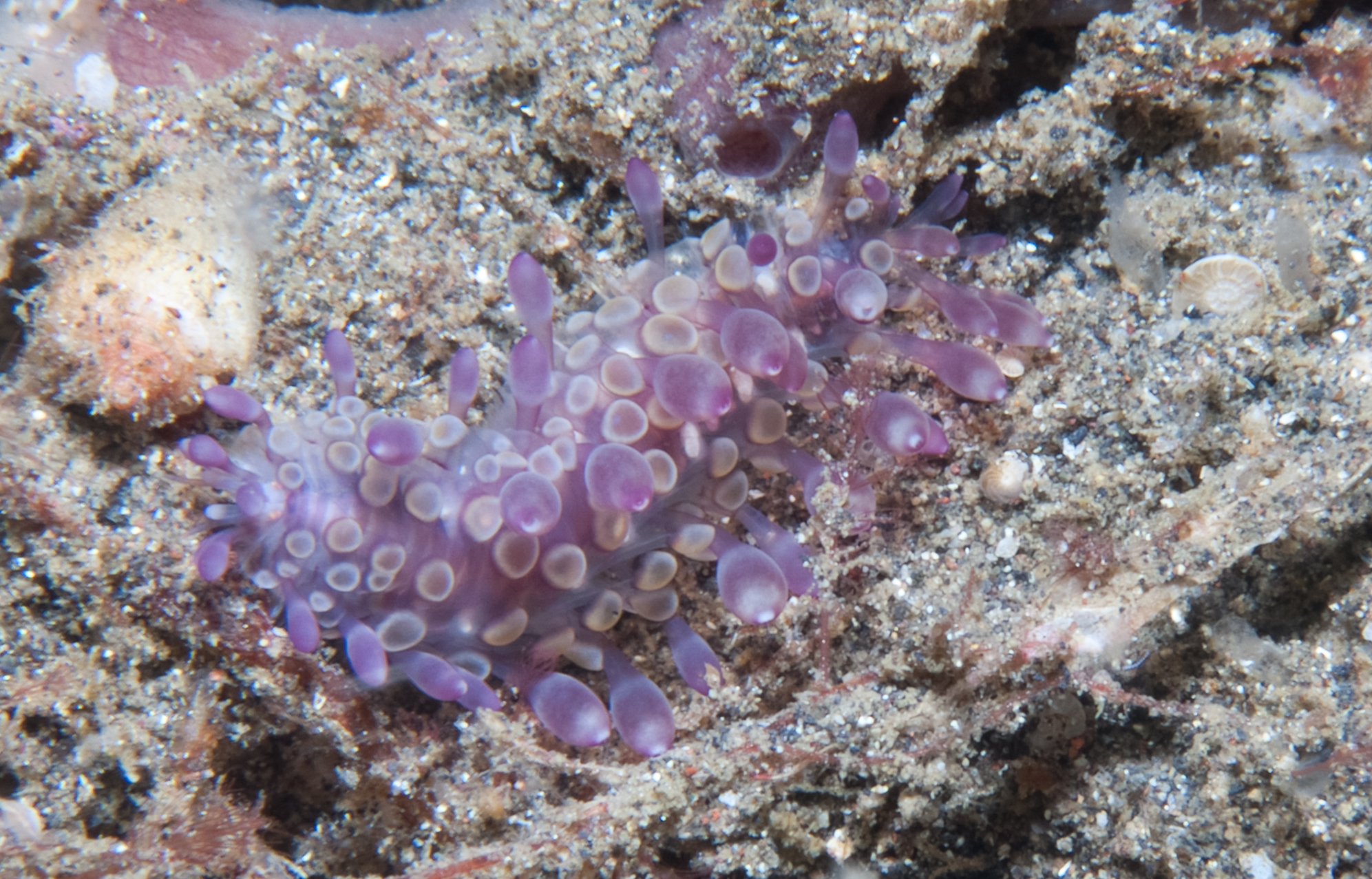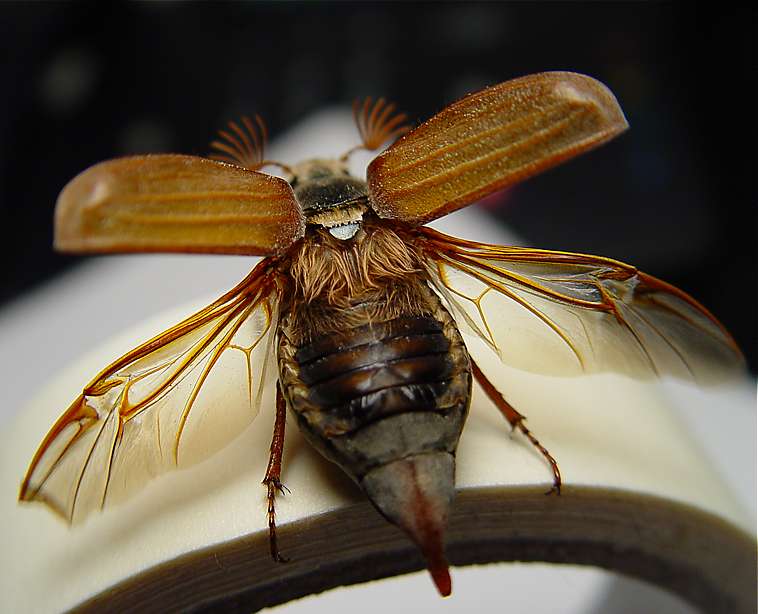|
Phyllodocida
Phyllodocida is an order of polychaete worms in the subclass Aciculata. These worms are mostly marine, though some are found in brackish water. Most are active benthic creatures, moving over the surface or burrowing in sediments, or living in cracks and crevices in bedrock. A few construct tubes in which they live and some are pelagic, swimming through the water column. There are estimated to be more than 4,600 accepted species in the order. Characteristics Phyllodocida are segmented worms and range in size from a few millimetres long to over a metre. Each segment bears a pair of paddle-like parapodia. The prostomium generally has one or two pairs of eyes, a dorsal pair of antennae, a ventral pair of sensory palps and a pair of organs on the neck. The peristomium is a ring, often hidden dorsally by the prostomium and the first segment. There is a muscular proboscis with one or more pairs of jaws. The next few segments tend to differ from those further back in having enlarged d ... [...More Info...] [...Related Items...] OR: [Wikipedia] [Google] [Baidu] |
Tomopteris
The gossamer worm (''Tomopteris'', Neo-Latin from Greek meaning "a cut" + "wing" but taken to mean "fin") is a genus of marine planktonic polychaetes. All described species are known to be holoplanktic, meaning that they spend their entire life cycles in the water column. E. Newton Harvey had noted the unusual yellow bioluminescence occurring from the parapodia. There are very few known marine animals that exhibit yellow luminescence. Many species of plankton are known to display this property of bioluminescence. The mechanisms of this process are not well understood; only that they do not use any of the currently known luciferins. If disturbed, a few species are known to release bioluminescent particles from their parapodia, though possibly all species of ''Tomopteris'' do this. It is thought that this mode is to distract predators, analogous to Chaff (countermeasure), chaff or flares dispensed from military aircraft during evasive maneuvers. Generally, gossamer worms grow to ... [...More Info...] [...Related Items...] OR: [Wikipedia] [Google] [Baidu] |
Antenna (biology)
An antenna (plural: antennae) is one of a pair of appendages used for Sensory system, sensing in arthropods. Antennae are sometimes referred to as ''feelers''. Antennae are connected to the first one or two Segmentation (biology), segments of the arthropod head. They vary widely in form but are always made of one or more jointed segments. While they are typically sensory organs, the exact nature of what they sense and how they sense it is not the same in all groups. Functions may variously include sensing tactition, touch, air motion, heat, vibration (sound), and especially insect olfaction, smell or gustation, taste. Antennae are sometimes modified for other purposes, such as mating, brooding, swimming, and even anchoring the arthropod to a substrate (biology), substrate. Larval arthropods have antennae that differ from those of the adult. Many crustaceans, for example, have free-swimming larvae that use their antennae for swimming. Antennae can also locate other group members i ... [...More Info...] [...Related Items...] OR: [Wikipedia] [Google] [Baidu] |
Polynoidae
Polynoidae is a family (biology), family of marine Polychaete worms known as "scale worms" due to the scale-like elytron (Annelida), elytra on the dorsal surface. Almost 900 species are currently recognised belonging to 9 subfamilies and 167 genera. They are active hunters, but generally dwell in protected environments such as under stones. The group is widely distributed from shallow Intertidal zone, intertidal waters to Hadal zone, hadal trenches. They are the most diverse group of polychaetes in terms of genus number and second most diverse in terms of species number which is almost 8% of all segmented worm species. Description Most Polynoidae species are short and flattened, but can reach as much as 20 cm in length and 10 cm width in ''Eulagisca gigantea'' and ''Eulagisca uschakovi''. Individuals are usually covered almost entirely by Elytron (Annelida), elytra, which can be shed and regenerated in many species. The elytra of some species are faintly bioluminescent ... [...More Info...] [...Related Items...] OR: [Wikipedia] [Google] [Baidu] |
Pholoidae
Pholoidae is a family of polychaetes belonging to the order Phyllodocida Phyllodocida is an order of polychaete worms in the subclass Aciculata. These worms are mostly marine, though some are found in brackish water. Most are active benthic creatures, moving over the surface or burrowing in sediments, or living in cr .... Genera: * '' Imajimapholoe'' Pettibone, 1992 * '' Laubierpholoe'' Pettibone, 1992 * '' Metaxypsamma'' Wolf, 1986 * '' Pholoe'' Johnston, 1839 * '' Taylorpholoe'' Pettibone, 1992 References {{Authority control Phyllodocida Annelid families ... [...More Info...] [...Related Items...] OR: [Wikipedia] [Google] [Baidu] |
Eulepethidae
Eulepethidae is a family of polychaetes belonging to the order Phyllodocida Phyllodocida is an order of polychaete worms in the subclass Aciculata. These worms are mostly marine, though some are found in brackish water. Most are active benthic creatures, moving over the surface or burrowing in sediments, or living in cr .... Genera: * '' Eulepethus'' Chamberlin, 1919 * '' Grubeulepis'' Pettibone, 1969 * '' Lamelleulepethus'' Pettibone, 1986 * '' Lammeleulepethus'' Pettibone, 1986 * '' Mexieulepis'' Rioja, 1962 * '' Pareulepis'' Darboux, 1900 * '' Proeulepethus'' Pettibone, 1986 References {{Authority control Phyllodocida Annelid families ... [...More Info...] [...Related Items...] OR: [Wikipedia] [Google] [Baidu] |
Aphroditidae
Aphroditidae is a family of annelids belonging to the order Phyllodocida. Genera Genera: * '' Aphrodita'' Linnaeus, 1758 * '' Aphrogenia'' Kinberg, 1856 * '' Cyanippa'' Lucas, 1840 * '' Halogenia'' Horst, 1916 * '' Hermione'' Blainville,1828 * '' Hermionopsis'' Seidler, 1923 * '' Hermonia'' Hartman, 1959 * '' Heteraphrodita'' Pettibone, 1966 * '' Homaphrodite'' Gall & Grauvogel, 1966 * '' Laetmonice'' Kinberg, 1856 * ''Milnesium'' * '' Palaeoaphrodite'' Alessandrelli & Teruzzi, 1986 * ''Palmyra Palmyra ( ; Palmyrene dialect, Palmyrene: (), romanized: ''Tadmor''; ) is an ancient city in central Syria. It is located in the eastern part of the Levant, and archaeological finds date back to the Neolithic period, and documents first menti ...'' Savigny, 1818 * '' Pholoicola'' * '' Pontogenia'' Claparède, 1868 References {{Authority control Phyllodocida Annelid families ... [...More Info...] [...Related Items...] OR: [Wikipedia] [Google] [Baidu] |
Acoetidae
Acoetidae is a family of polychaete worms in the order Phyllodocida. Genera * '' Acoetes'' Audouin & Milne Edwards, 1832 * '' Euarche'' Ehlers, 1887 * '' Eupanthalis'' McIntosh, 1876 * '' Eupolyodontes'' Buchanan, 1894 * '' Neopanthalis'' Strelzov, 1968 * '' Panthalis'' Kinberg, 1856 * ''Polyodontes ''Polyodontes'' is a genus of polychaete worms in the order (biology), order Phyllodocida. Species * ''Polyodontes atromarginatus'' Horst, 1917 * ''Polyodontes australiensis'' (McIntosh, 1885) * ''Polyodontes frankenbergi'' Pettibone, 1989 * ' ...'' Renieri in Blainville, 1828 * '' Zachsiella'' Buzhinskaja, 1982 References World Register of Marine Species External links * * {{Authority control Phyllodocida Annelid families ... [...More Info...] [...Related Items...] OR: [Wikipedia] [Google] [Baidu] |
Monophyly
In biological cladistics for the classification of organisms, monophyly is the condition of a taxonomic grouping being a clade – that is, a grouping of organisms which meets these criteria: # the grouping contains its own most recent common ancestor (or more precisely an ancestral population), i.e. excludes non-descendants of that common ancestor # the grouping contains all the descendants of that common ancestor, without exception Monophyly is contrasted with paraphyly and polyphyly as shown in the second diagram. A ''paraphyletic'' grouping meets 1. but not 2., thus consisting of the descendants of a common ancestor, excepting one or more monophyletic subgroups. A ''polyphyletic'' grouping meets neither criterion, and instead serves to characterize convergent relationships of biological features rather than genetic relationships – for example, night-active primates, fruit trees, or aquatic insects. As such, these characteristic features of a polyphyletic grouping are ... [...More Info...] [...Related Items...] OR: [Wikipedia] [Google] [Baidu] |
Elytra
An elytron (; ; : elytra, ) is a modified, hardened forewing of beetles (Coleoptera), though a few of the true bugs (Hemiptera) such as the family Schizopteridae are extremely similar; in true bugs, the forewings are called hemelytra (sometimes alternatively spelled as "hemielytra"), and in most species only the basal half is thickened while the apex is membranous, but when they are entirely thickened the condition is referred to as "coleopteroid". An elytron is sometimes also referred to as a shard. Description The elytra primarily serve as protective wing-cases for the hindwings underneath, which are used for flying. To fly, a beetle typically opens the elytra and then extends the hindwings, flying while still holding the elytra open, though many beetles in the families Scarabaeidae and Buprestidae can fly with the elytra closed (e.g., most Cetoniinae; ). In a number of groups, the elytra are reduced to various degrees, (e.g., the beetle families Staphylinidae and Ripipho ... [...More Info...] [...Related Items...] OR: [Wikipedia] [Google] [Baidu] |
Scavenger
Scavengers are animals that consume Corpse decomposition, dead organisms that have died from causes other than predation or have been killed by other predators. While scavenging generally refers to carnivores feeding on carrion, it is also a herbivorous feeding behavior. Scavengers play an important role in the ecosystem by consuming dead animal and plant material. Decomposer, ''Decomposers'' and detritivores complete this process, by consuming the remains left by scavengers. Scavengers aid in overcoming fluctuations of food resources in the environment. The process and rate of scavenging is affected by both Biotic component, biotic and Abiotic component, abiotic factors, such as carcass size, habitat, temperature, and seasons. Etymology Scavenger is an alteration of ''scavager,'' from Middle English ''skawager'' meaning "customs collector", from ''skawage'' meaning "customs", from Old North French ''escauwage'' meaning "inspection", from ''schauwer'' meaning "to inspect", of ... [...More Info...] [...Related Items...] OR: [Wikipedia] [Google] [Baidu] |
Predation
Predation is a biological interaction in which one organism, the predator, kills and eats another organism, its prey. It is one of a family of common List of feeding behaviours, feeding behaviours that includes parasitism and micropredation (which usually do not kill the Host (biology), host) and parasitoidism (which always does, eventually). It is distinct from Scavenger, scavenging on dead prey, though many predators also scavenge; it overlaps with Herbivore, herbivory, as Seed predation, seed predators and destructive frugivores are predators. Predation behavior varies significantly depending on the organism. Many predators, especially carnivores, have evolved distinct hunting strategy, hunting strategies. Pursuit predation involves the active search for and pursuit of prey, whilst ambush predation, ambush predators instead wait for prey to present an opportunity for capture, and often use stealth or aggressive mimicry. Other predators are opportunism, opportunistic or om ... [...More Info...] [...Related Items...] OR: [Wikipedia] [Google] [Baidu] |
Chaeta
A chaeta or cheta (; ) is a chitinous bristle or seta found on annelid worms, although the term is also frequently used to describe similar structures in other invertebrates such as arthropods. Polychaete annelids (''polychaeta'' literally meaning "many bristles") are named for their chaetae. In Polychaeta, chaetae are found as bundles on the parapodia, paired appendages on the side of the body. The chaetae are epidermal, extracellular This glossary of biology terms is a list of definitions of fundamental terms and concepts used in biology, the study of life and of living organisms. It is intended as introductory material for novices; for more specific and technical definitions ... structures, and clearly visible in most polychaetes. They are probably the best-studied structures in these animals. Segments bearing chaetae are called chaetigers. Use in taxonomy and identification The ultrastructure of chaetae is fundamentally similar for all taxa but there is vast diversity ... [...More Info...] [...Related Items...] OR: [Wikipedia] [Google] [Baidu] |



